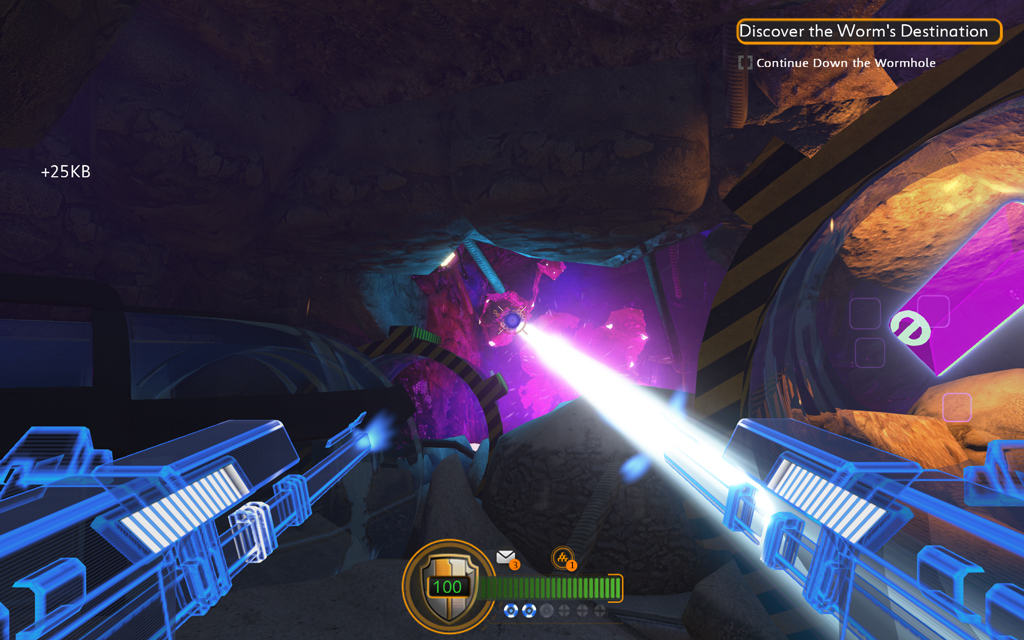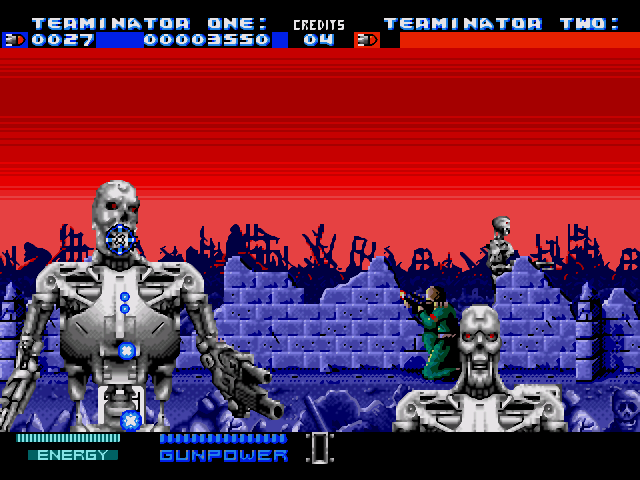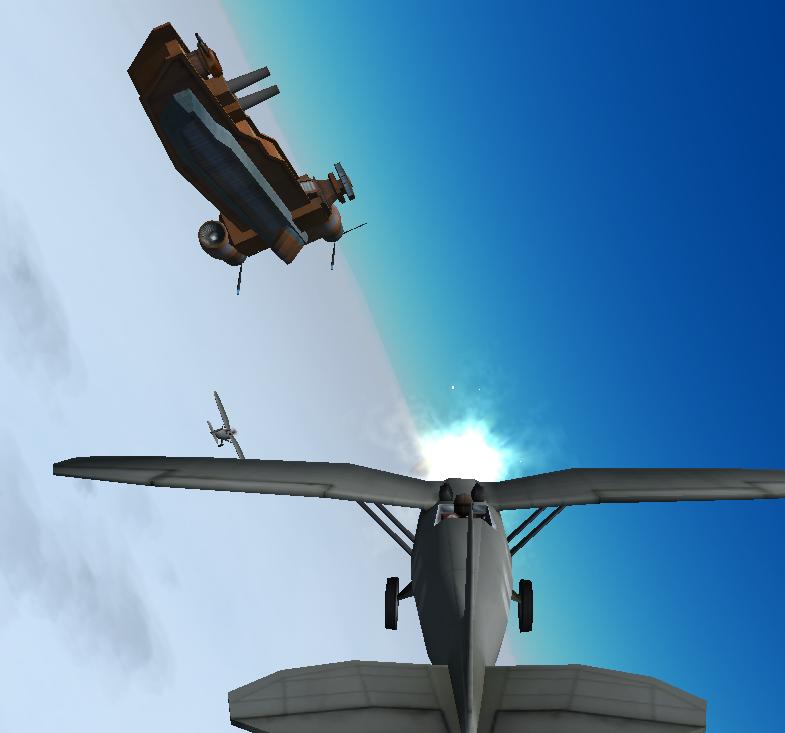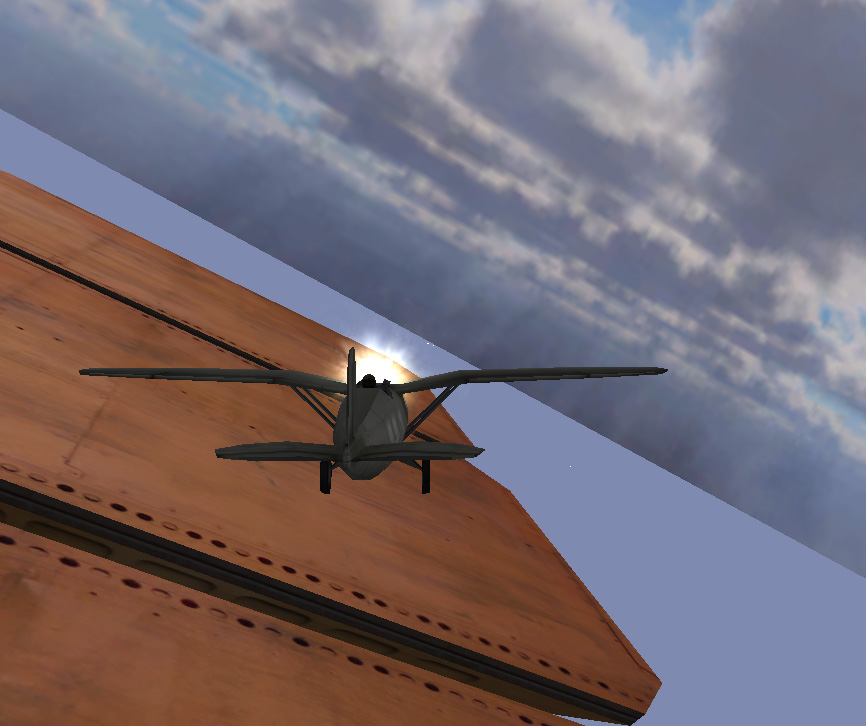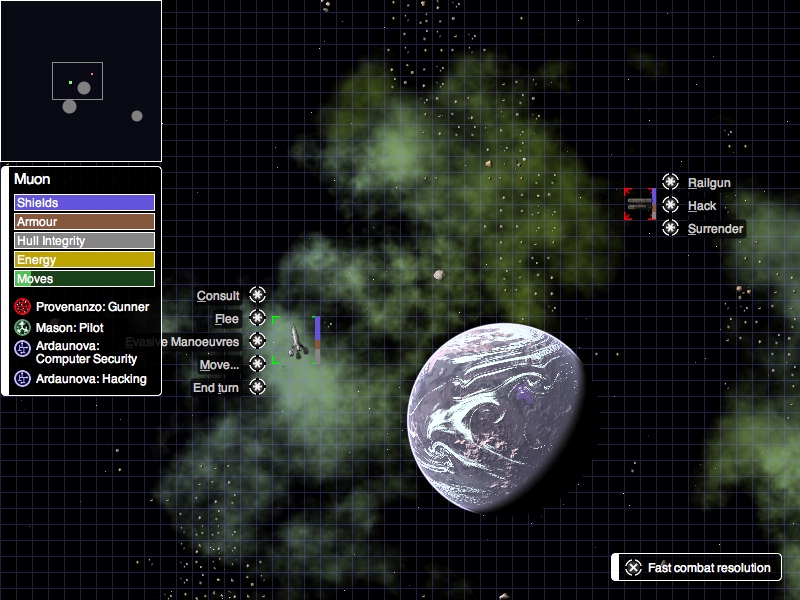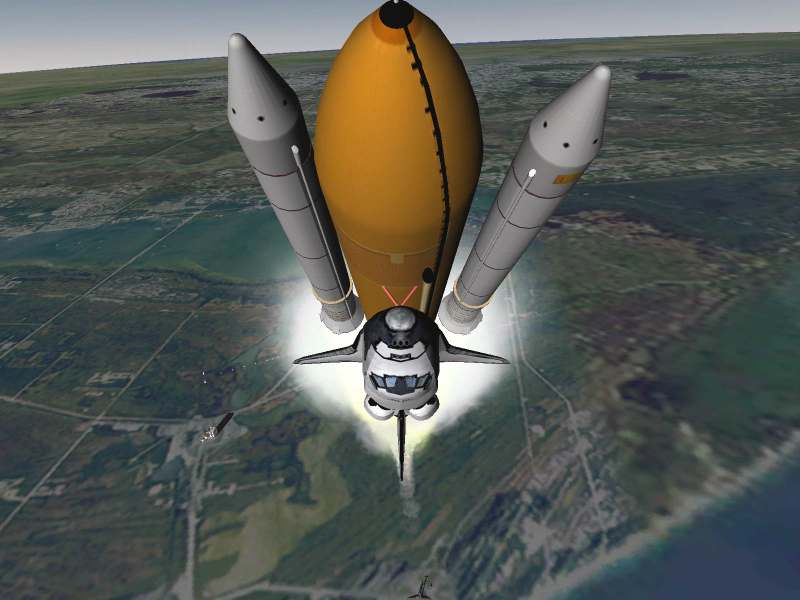It’s been a while since my last run-in with the digital plague. However it is no less cathartic to play Retrovirus, a neat little resurrection of the 6-degrees-of-freedom-shooter. The game tasks you with seeking out and eliminating the dirty purple globs of stylised virus, which are running amok in your computer’s pristine starship-like virtual space.
Category Archives: Gaming
Game Design for War Against Machines
The central theme to the Terminator franchise is Man vs the Machines. While I am very fond of Machines (and find the concept of their rebellion seriously flawed), I’ve always found this a very interesting premise. It is also one that is practically screaming to be utilised in computer games; as anyone who has played a co-operative computer game might have noticed, that is the exact conflict they are engaged in.
Yet its an opportunity that has been completely squandered. The last offering from the Terminator universe, as far as I’m aware, was just another setpiece shooter taking us through cardboard-cutout locales with pre-scripted missions and paths. Strip out the graphics, and it’s Medal of Honor. No Terminator game to date pits you, alongside an army of humans only, in a battle against an army of machines controlled by a central AI opponent ‘commander’ (in fact, I can think of only one game at all that does anything resembling this). And even if a Battlefield clone were to surface that did pretty much this, they probably wouldn’t do what I have in mind. That’s why I’m going to ask the industry to just shutup a sec. I’ve got an idea.
Azimuth Skies – Weapon Grouping
Possibly the biggest challenge in the development of Azimuth Skies, besides making the ship construction accessible to a non-modding player, is organising the weapons and how they will be controlled/fired. The system in Iron Skies presently is a simple enough evolution from Battlefield-style games where you simply switch between several turrets and fire them like a First Person Shooter. The big complication is in the custom ship structure; there has to be a simple way that shipbuilders can group and setup their turrets without bogging the whole thing down. I could just make things easy on myself and go for a system where turrets are placed on ‘hardpoints’ on sections, but that’s just too tired and limiting for my taste! So now I find myself in crazy territory, as not only are all the components of a ship in Azimuth Skies able to combine in any configuration, but the weapons can be wherever you can fit them in.
And just how do I define where things do and don’t fit, anyway? Well you shall see later when I get into the shipbuilder with a little more gusto. Right now my priority is making a skirmish mode type thing that’s actually got some solid gameplay behind it. It’s all just too unstable at present.
And so we come to my current task. The Weapon Group system evolved out of the need for organising varying numbers of turrets in varying directions with as much automation as possible. The ship’s creator places the turrets on the ship first. Then, they select all the weapons to be in a group together. This then creates a Weapon Group, say Group 1. These form the basis of your combat gameplay.
Pressing 1 takes the player to that group. This will attach the camera to an invisible object in a set place on the ship, the group viewpoint. The camera will pivot around this point. It is then offset by whatever Vector3 is specified, and a Crosshair is created in a straight line, at a specified distance from the group viewpoint (parented to it, like the camera). Thus, when the player moves the mouse, the group viewpoint rotates on the relevant axis and the crosshair points in line with it. Meanwhile, the group instructs all the turrets that are listed as a part of it to track that crosshair object. Rolling the mouse wheel will change the range of the crosshair +/- 50%.
The result should be a turret system that doesn’t suck! I’d like to illustrate more graphically, but I’m pressed for time and I think it’s probably better spent actually solving the problem. Wish me luck.
Minecraft Madness
Last week I acquisitioned a Minecraft server, uploading the world from our LAN games so that it may continue to live on in eternal online form. Despite only a few of the potential players being able to make it at the moment, it is already developing an interesting character of its own to the point where my 3rd-party-generated maps look like the sort that might come with a dungeon crawling RPG.
So I’ve made a little page on this site for the LAN group, an assortment of digicrats and consolemancers known collectively as the Rapier Foundation. Check out the page on the top bar just up there! At the moment it’s just stuff for the Minecraft server, but I hope to get around to putting more generic LAN-related stuff on there too at some point.
And for those with an interest in my development projects; have no fear, all is still going well! But with the absolutely incredible Little Big Planet 2 in my hands now too (and Test Drive Unlimited 2 around the corner next week), it’s looking to be a decent period of rest & relaxation!
Welcoming 2011 with Wobells
January 2011 marches on and I still don’t have an entry for the new year. Well, here it is. Now, what’s been going on? What indeed.
I just released Tales of Wobells on the neat indie dev website GameJolt. I was thinking of also putting it up here, but right now I think I ought to get on with other things. For those unaware of what it even is, ToW was a joke retro RPG game I somehow spent hundreds of hours between 2002 and 2008 putting together. It follows the loose story of a bunch of kids based mostly on people I know, in a world that’s reminiscent of a dream one might have after watching 24 hours of solid Youtube.
In the world of sane games, work on Azimuth Skies continues. I have begun putting the ship editor together, as in my mind it will be one of the core features to the appeal and I’ll need to sink into it sooner rather than later. And on that note I shall end this brief entry and get cracking!
Azimuth Skies!
A lot has been going on recently. Partly due to the holiday season, partly due to a foul little piece of malware corrupting my windows installation and effectively wasting a week. However, much has changed since the last webplayer. There are more ships, they are more sophisticated, several things have been fixed and I really only have AI left to do (and some sounds) before the core gameplay model is complete. Check out the Webplayer above to give it a go!
Perhaps the biggest change has been of name. For the last four years, this project has been known as Iron Skies. A name I came up with for the incarnation that was my university project, I decided to change it in light of the Finnish indie film of a very similar name.
My game is now known as Azimuth Skies. Seeing as the name of the world within which it is set is Azimuth, this seemed like an obvious choice. I also toyed with the likes of Azimuth Wars and Azimuth Air Battles, but there really is (or at least, will be) more to the game than just combat.
For the uninitiated, Azimuth is “an angular measurement in a spherical coordinate system”, such as a compass bearing. It is also a term found in artillery, meaning direction of fire. So now you know.
Iron Skies Devblog – Some Changes
From now on I will be streamlining the devblog a little. The webplayer will now be in one place, (on that top bar up there), and I will continue to update it, commenting on updates from time to time as entries here, so feel free to check back occasionally. Here’s what’s in the latest version:
– Ship’s guns now present and working; the first ship has a single forward cannon for you to play with
– Skyfighters added back in. With their new and shiny flight model that’s almost complete.
– Ships can ram each other! Collision causes damage finally, something the old version never got around to having. The damage model will change too; I want some components to leave behind a ‘shell’ of wreckage so that you don’t get weird gaps when a central system (like the hull) is destroyed. A hierarchy would be another alternative, but I want to make shipbuilding as simple as possible.
– Some targets to shoot at. Both the skyfighters and ship cannons can take em out. You can even ram the crap out of them.
As a final note, I am considering a new name for the project. Since my first version way back in 2006, a Finnish film studio has been working on Iron Sky, a movie about space nazis. I’ve known about it for a few months now, but the fact is it’s inevitably more publicised than mine and to continue using such a similar name is only going to cause me trouble later on. So if you have any ideas, feel free to suggest them!
At the very least it might prevent confusion around the fact that I’ve started again from scratch…
A Demo of “Explorers”
Alright so the progress on Iron Skies is currently agonisingly slow, but this is mainly because I’ve been cooking up a quick portfolio project currently titled “Explorers” (well, that and Minecraft). It’s named after on a long, proud and (oh, surprise) unfinished lineage of Games Factory games I made well over twelve years ago. The premise was simply planetary exploration, although in this latest form your mission is more archaeological than recon.
You are an AP3 droid, remotely controlled from your ship to investigate dangerous worlds and collect clues, leading to a find piece of ancient treasure! It’s all done with a very old skool N64 feel, as I always wanted to do a game like that. A lot of the art is taken from a similar cancelled joint project undertaken last year. The main purpose of it is to show my ability to make art, code, sound and prose and meld them into a game pretty much autonomously. This is also one of the few ways a game designer can showcase the high-level application of game design itself.
So here’s an early version. [Link removed due to changes in the unity webplayer breaking pretty much everything]
- Welcome to Nash! Feel free to explore.
- See how many Clues you can collect (there’s 16 in all).
- I don’t want it to get too complex, but there’s still some things I’ve yet to add to spice up the gameplay a little
- Not to mention fix several bugs and replace some placeholders
Please have a go and tell me what you think! I will try to update it as I go, and of course get right on to Iron Skies.
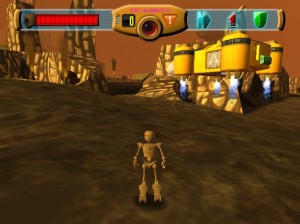
Play Explorers Web Demo v1
Quick note on the music: I’ve used some bgm from an old game for now as this is only a quick webplayer demo. It will be replaced as a priority, but right now I don’t think anyone will care; it just sounded odd with only sound effects. If it causes a huffle I’ll take it down of course, but geez, come on.
Iron Skies Devblog – Trying out the skyfighter
One of the great things about Unity is its versatility, most notably that it runs in a browser. The Webplayer version builds from the exact same project as the Windows or OSX download does, and the plugin to run it is one of the easiest, most automatic things I’ve ever downloaded. Now, Iron Skies may end up a little too much for browser play, but this also has the interesting advantage of providing actual playable demonstrations to the devblog!
This demo has no gameplay yet I’m afraid, it merely demonstrates skyfighters: the little aerofoil craft that can swing the tide of battle. While this isn’t a flight sim and is mainly about airships, I have been tweaking the skyfighter controls relentlessly and have just overhauled them again. The basic movement and control mechanics are important to nail down for all player-controlled craft, and that I’m not too far off now. Once it feels good, I can start getting into the gritty detail of combat and gameplay.
Space Exploration & Orbiter
While riding the highways and byways of the hypertext stream (oh grief, please don’t ever let me use that sentence again) I recently encountered two unique Space-themed titles of a more exploratory and scientific kind than many of us are used to. As an intrepid explorer myself (I occasionally drive to Wales), I was very interested to delve into them.
For anyone with the desire to become the next pulp-scifi space captain (and possessing the rudimentary minimum imagination necessary to read a book), Space Exploration : Serpens Sector is a work-in-progress worth a look. Fundamentally, the game focuses on a top-down view of an area of star systems which you can visit with a simple click. However, each journey costs fuel to get there (and of course, to get back). Fortunately, your friends at the home station are on hand to reward your exploring efforts with more fuel, so it forms a principle resource.
All this would be pretty dull were it not for the fact that every new star system holds something different; contact with new races, hanging out in bars on asteroids, having your crew abducted… every voyage plays out like an episode of Star Trek. Of course, with this incredible scope these encounters are text-based, but as stated earlier this gives it quite a literary feel and the entirely random universe varies well.
Additionally, battles are fought out using a detailed (if sometimes ponderous) combat engine of a similar look and feel to the galactic map. A nice touch is that you can ask your crew for advice in battle, advice that is actually worth listening to. The version I played was the tenth, and current, build, which seemed very stable and gave no problems. And unlike many indie developers that feel cornered into using awful DRM in their games, Metal Beetle have stated the game will be free; only the content-adding expansions will cost anything. Read more about that here.
The second game, which is not so much a game as an immensely complex freeware simulator of space flight, is called Orbiter. Featuring the Space Shuttle, the ISS, plus a number of theoretical craft of the near future, it almost reminds me of the first time I played Xplane back in its old days. It has that charm, that strange attraction that comes from simulating just about everything that makes you go “I wonder what happens if I do this.”
Orbiter is 100% a simulator. One way to tell this is that I have only really been able to figure out how to pitch, bank and yaw. After connecting a joystick I discovered I could throttle the forward thrusters. Yet it had me spinning in orbit for half an hour, fascinated, attempting to try this and that to see just how easy it is to knock a shuttle out of orbit. I was expecting the slightest goof to send me plummeting toward the big blue thing, but here it would seem it’s almost as hard to hit a planet as it is to miss it; several times I found myself accelerating away from Earth accidentally at ridiculous speeds. This is the nature of orbits, although one always wonders what is accurate and what isn’t in a simulator: especially when my triumphal crash into the pacific ocean actually made me bounce a kilometre back up into the air.
Orbiter is a geek’s toy, no doubt about that. But it does come with a plethora of preset scenarios and recorded sessions to help you see it all without having to first attain a Masters in astrophysics. You can watch the shuttle launch in the skilled hands of an expert, which gives you an idea of the scale and speed of the real thing. Many other situations and some very fine graphics (for the most part) make it an educational, often enjoyable indulgence; especially for space nerds like me that could reel off all the planets and moons from the age of five.
My only real gripe was the lack of sound, even in the atmosphere (but as you’re mostly in space this isn’t a biggie). The lack of planetary detail beyond Cape Kennedy is a shame too, but an understandable limitation. I would have liked to have seen better simulation of impact with the ocean/land at 100 metres per second, but I guess they aren’t supposed to show shuttles disintegrating in a game of this nature.
Overall, both of these are labours of love and definitely niche programs, but it is refreshing to see an experience you just can’t find elsewhere!

